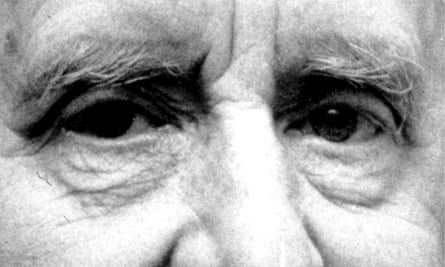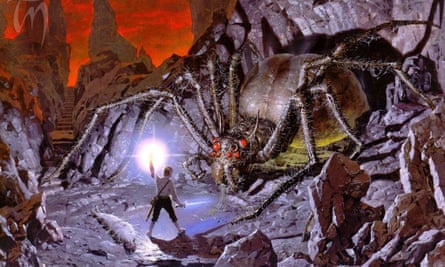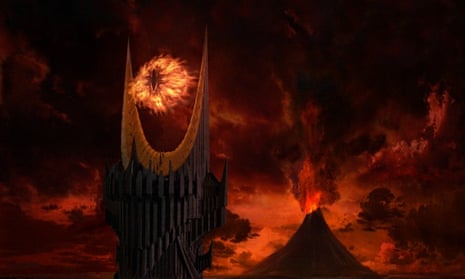A really bravura villain grabs you by the throat. From childhood bogeymen via the dastards and arch-nemeses of adolescence, all the way to adulthood’s more nuanced sociopaths, schemers and political tyrants, they’re the grit that makes literary pearls, the dynamos who keep us reading – and part of their appeal is their infinite variety: there are as many brands of evildoer as there are stars in the sky, fish in the ocean. Collectively, they adhere to a modified version of the Anna Karenina principle: all saints are alike; each sinner sins uniquely. How, then, are you supposed to pick a favourite?
In my case, it comes down – in part, at least – to first contact. Assuming we’re among the lucky ones, our initial encounter with evil – with the idea that there are those out there who, given the chance, would do us harm – takes place in the realm of fiction. Fairytales – with their murder, bestiality, suicide, rape, incest and cannibalism – are the obvious jumping-off point. In The Uses of Enchantment, Bruno Bettelheim deemed their unflinching portrayal of wickedness essential to our education – a necessary corrective to “the dominant culture [that] wishes to pretend, particularly to children, that the dark side of man does not exist”. Certainly, those tangled-wood images of wolves got up as grandmothers and witches in sugar-coated houses retain a disproportionate power to disturb. For me, though, despite a protracted phase during which I hid my Ladybird Sleeping Beauty at bedtime in case the witch climbed out to get me, the baddie who informed my vision of evil – the one against whom all subsequent horrors would be measured – didn’t figure on the cover of a fairytale book. His defining feature is that we never lay eyes on him.
When I was five, my child-of-the-60s father decided he could wait no longer to share with me the joys of JRR Tolkien’s The Hobbit. When I was six, we moved on to The Lord of the Rings. This involved, he tells me, a fair amount of paraphrasing; it quickly became clear that, if he intended his audience to stay awake, it was sensible to skip over the arts-and-craftsy elvish bits. But from the off, I loved it. I loved the quest narrative’s clarity and against-overwhelming-odds sense of purpose; the hobbits who, my dad informed me, were about my height; the richness and coherence of the universe (it’s possible my six-year-old self didn’t put it quite like that). I loved the way the magic ring starts off as the world’s niftiest gadget and slowly morphs into something disquieting, then alarming, then purely, world-wreckingly deadly. I loved the battle scenes. I loved Gandalf. And I was reduced to quivering jelly by the book’s baddies.

Regarding baddies, Tolkien does a fair job of covering all bases. First, there’s the folklorish horror of the Black Riders – the Ringwraiths, whose power and terror grows in proportion to their proximity to Mordor and their master, but who were never more dreadful, to me, than during the lo-fi but mortal game of cat-and-mouse they play with Frodo and his companions at the beginning of the saga, turning what ought to have been an easy yomp through gentle countryside – the sort with which I thought I was familiar from The Hobbit – into the stuff of nightmare.
Then there’s Saruman, the sophisticated, modern villain; a good-guy-gone-bad, whose original drive to technological improvement and political solutions morphs into a seduction by power that sees him become nothing more than a tool for the dark. And Gollum: broken by his ages-long ownership of the ring; a cringing, attenuated foreshadow of what the future holds for Frodo if he’s unable to relinquish his burden when it finally comes to it. There are monsters – the Balrog, who drags Gandalf into the abyss, and Shelob, the giant spider whom I credit with triggering a lifetime of arachnophobia. But behind them all, there is Sauron. And Tolkien’s genius, when conjuring him, is, more or less, not to conjure him at all.

Throughout The Lord of the Rings Sauron is never described: we’re never ushered into his presence; we don’t hear him speak. All we see is his influence: the endless armies of orcs who ripple forth at his command; the tribes of men who fall beneath his sway; the scorched and blasted plains of Mordor, where nothing grows; the way his malignancy intrudes on the counsels even of the allies ranged against him. Everything yields to him, even the weather: when the fellowship attempts to cross the Misty Mountains and is beaten back by a storm, Boromir wonders whether the snow is:
‘… a contrivance of the Enemy ... They say in my land that he can govern the storms in the Mountains of Shadow that stand upon the borders of Mordor. He has strange powers and many allies.’
’His arm has grown long indeed,’ said Gimli, ’if he can draw snow down from the North to trouble us here three hundred leagues away.’
’His arm has grown long,’ said Gandalf.”
It’s a bold move, to leave the book’s central evil so undefined – an edgeless darkness given shape only through the actions of its subordinates. But the effect is to create a truly unforgettable baddie: vaster, bolder and more terrifying through his absence than he could ever have been through his presence. When we give shape to something, we circumscribe it; the limits we impose are unavoidably reductive. As I grew older and read (and reread) The Lord of the Rings to myself – and, over recent months, to my own six-year-old – I was able, as I couldn’t as a child, to perceive the flaws: the social conservatism; the overly archaic language; the dearth of women. But 30 years on from my first encounter with him, Sauron’s power to chill hasn’t diminished one iota. Our capacity to imagine and comprehend evil changes as we age, and because Tolkien leaves his villain untrammelled – a blank space upon which we may each project our own bete noire – he evolves as we do. We never outgrow him.
Other authors have attempted to the same trick. It’s a technique Stephen King emulates to a degree in The Stand – which King himself called his attempt “to write a fantasy epic like The Lord of the Rings, only with an American setting” – with his hearty villain Randall Flagg, who appears out of nowhere, walking along a deserted road. JK Rowling, meanwhile, tries something similar in Harry Potter with Voldemort who, over the course of the seven books, remains more talked about than talking. But neither novelist quite has Tolkien’s audacity; both allow their villians to take shape before the books’ end, and see them reduced as a result. Sauron – the Dark Lord, the Necromancer, the Lord of the Rings – remains invisible to the last: to the moment when the ring is finally cast into the fires of Mount Doom, and “black against the pall of cloud, there rose a huge shape of shadow, impenetrable, lightning-crowned, filling all the sky. Enormous it reared above the world, and stretched out towards them a vast threatening hand, terrible but impotent: for even as it leaned over them, a great wind took it, and it was all blown away, and passed; and then a hush fell.”




Comments (…)
Sign in or create your Guardian account to join the discussion